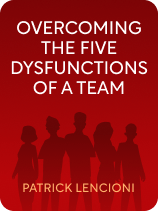

This article is an excerpt from the Shortform book guide to "Overcoming the Five Dysfunctions of a Team" by Patrick Lencioni. Shortform has the world's best summaries and analyses of books you should be reading.
Like this article? Sign up for a free trial here.
At what point is a team too large? Are team-building activities worth it?
Renowned business consultant Patrick Lencioni knows all about teams. In his book Overcoming the Five Dysfunctions of a Team, he defines what a team is and provides guidance on putting a team together and getting it on the right track from the start.
Read on for Lencioni’s recommendations for the team-building process.
The Team-Building Process
Lencioni starts by giving his definition of a team: a group of up to 12 people who come together and work collectively to meet shared objectives and put the group’s needs above their own. He adds that smaller teams are often the most effective, and you should rarely—if ever—try to make a team larger than a dozen people. Groups larger than that have too many opportunities for interpersonal conflicts, making it exponentially more difficult to arrive at decisions they all agree with.
(Shortform note: In many cases, even 12 people on a team can be too many. Some reports show that the average size of an executive team of a large company is now 10, and even that’s proving to be expensive and cumbersome—team members get paid for attending meetings that often don’t concern them, and those meetings frequently run over time as the large groups try to reach a consensus that satisfies everyone. It’s therefore wise to keep your team as small as possible while making sure that all necessary roles are filled.)
Lencioni notes that, during the team-building process, it’s very difficult to get people to go against their selfish instincts and work toward collective goals. He suggests tackling this problem by creating a timeline of specific team-building activities and objectives. This team-building process should be designed so team members will get to know each other, learn to trust one another, and (as much as possible) break their habit of focusing on themselves.

———End of Preview———
Like what you just read? Read the rest of the world's best book summary and analysis of Patrick Lencioni's "Overcoming the Five Dysfunctions of a Team" at Shortform.
Here's what you'll find in our full Overcoming the Five Dysfunctions of a Team summary:
- What "teamwork" actually means, and how to foster it
- Why trust is the most important element in an effective team
- The five impairments to teamwork and how to overcome them






